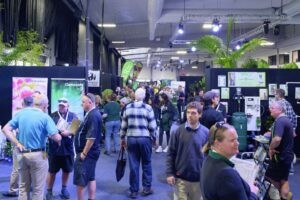
2025 Green Expo: Bringing industry together
By Gabrielle Stannus
Promotional material to market Greenlife Industry Queensland’s Green Expo certainly did not lie when it said this event brings together the best of the nursery and garden industry, with a wide range of displays and products all in one place. Held over (almost) two days at the Gold Coast Turf Club, the expo showcased greenlife, horticultural products, garden centre supplies and growing media, as well as a range of allied services including business and innovation, and training and research.
And the winners are …
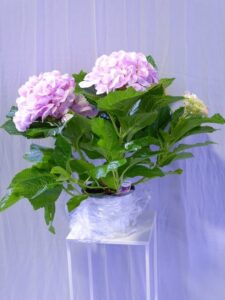
To satiate the curiosity of those unable to attend, I thought I would start my ‘tour’ of the 2025 Green Expo by sharing with you the winners of the Expo Spotlight competition. This year’s competition included two main categories: A) Best of Expo and B) Best New Product / Service. The judging panel comprised Jo Cave, CEO of Greenlife Industry Australia (GIA), Kerry Battersby, Queensland Farmers’ Federation, and Steve Walters from Plant Providers. Winners were announced at the Green Expo Dinner held on Tuesday 29 July 2025 at the Sea World Resort Conference Centre.
In Competition A, Sunflora Group took out ‘Best of Expo, Greenlife’ for their Hydrangea Plant, whilst Fernland won ‘Best of Expo, Allied Trade’ for their FloraFert Fertiliser Tablets. In Competition B, Australian Plant Specialists took out the ‘Best New Greenlife’ for Tristaniopsis ‘Sprite’, a compact, dwarf form of the popular native water gum suitable for small spaces as a low hedge or border, or in pots and planters for patios or courtyards. Pohlmans receiving an honourable mention for their Cyclamen ‘Dragon Blue’. Hortraco received the gong for ‘Best New Allied Trade’ for their Electrical Pot Mover, with Toowoomba Outdoor Power Products receiving an honourable mention for their 54ʺ Zero Turn Mower. In the People’s Choice Awards, Rocky Point won ‘Best Allied Trade Display’, whilst Big Leaf Wholesale Nurseries took out the awards for ‘Most Innovative Display’ and ‘Best Greenlife Display’.
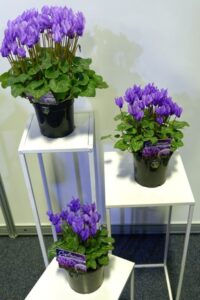
Best Greenlife Display
Big Leaf Wholesale Nurseries’ display certainly attracted a lot of attention during the expo. I could not help but ask if I could have my photo taken in what I called the ‘Tillandsia Throne’ that Keiran Studders and his team installed as a focal point. According to Kieran, that was exactly his intention, i.e. to encourage people to stop and take their photo to increase the visibility of his display, and more importantly, his brand: ‘With our stall, we try to create a sensory experience for people as a way for them to remember our brand. So, for us it is about engaging with our existing customers, some we have had for 20 years, but also to engage with new customers that come to this event as well. We want people to remember us. Every year we try to come up with a theme for our display. This year we have a Zen garden creating a feeling of harmony. We have incorporated other sensory elements, including music and smoke, to add to the atmosphere. The interactive chair makes people want to get involved. I can see a few people sitting down here striking a pose. The more our display engages people, the more chance we have got of seeing articles or photographs of it in horticultural publications. It is also the sort of thing that we can promote on our website. So, it has got lots of advantages, but the main thing is to keep getting our brand out there year after year.’
Green bat plant

Keiran’s was not the only greenlife that caught my eye. I caught up briefly with Bronwyn Hillier from Dracaena Farm Nursery who has just released a new green bat plant (Tacca chantrieri): ‘This is a nice addition to the black and the white bat plant that we currently stock. It is great for the tropical areas, so, Queensland and even some parts of northern New South Wales. It flowers from spring to autumn. Everyone is certainly excited to see a new colour being released. This has come from a tissue culture lab through one of my suppliers and is freely available. You do not have to have a high-paying job to get your hands on one. It makes it affordable for anybody to get a new variety. Retailers seem to be pricing it around the $25 to $30 mark, so it is very reasonable for a brand-new release.’
Bronwyn remains a big fan of the expo, telling me that her production nursery has participated in this event for over thirty years, ever since they have been in business: ‘We love coming to Expo[GS1] [JH2] . Our ordering trends have changed, people do a lot of ordering online through email. However, nothing beats catching up with people face to face, even if it is just once a year, to keep fostering and nurturing those relationships. It is wonderful.’
Rose miniature ‘Red Cascade’
Rhiana Pierce from Brisbane Valley Wholesale Nursery told me that she was present at the expo to let the market know that her business has changed from growing seedlings and 100 ml to 140 ml pots, including natives, perennials, and exotic shrubs. Rhiana’s display featured 14 types of Alstroemeria (princess lilies), and a new miniature climbing rose, ‘Red Cascade’.
Tibouchina ‘Melodie’

The Lakewood Propagation display featured a ‘Ferris wheel’ full of plants designed to catch the eye of passers-by. It worked on me! I stopped at this stall to have a chat with Mahnya Wood, who told me that this installation had been a hit with event-goers. Mahnya also showed me the new Tibouchina ‘Melodie’ that this production nursery is growing, a selection of ‘Jazzie’ with variegated foliage and pink buds opening to deep purple flowers. This variety is suitable for warm temperate, subtropical and tropical gardens.
Anthuriums
It was hard to walk past the Heatons Nursery stand without being captivated by the range of almost iridescent anthuriums on display! Peter Heaton told me his wholesale nursery has 30 to 40 new varieties of anthuriums which will become available over the next few years: ‘It is exciting to see what colours and forms are coming through, from variegated to spotty foliage, from purple to bright oranges, reds and pinks, and blacks and whites. These anthuriums are propagated from tissue culture, so they stay true to form. They are getting better at being cold hardy and holding more flowers and leaves.’ Peter says that anthuriums can be used in any situation where people want to look at flowers, ‘Whilst they need a lot of light to keep flowering, they will last longer than a bunch of flowers.’
One message from Peter that stuck with me is that sometimes ‘new’ is not necessarily better than ‘old’. Heatons Nursery also grows a range of ferns, which Peter thinks make the best indoor plant you can get: ‘They will handle any light conditions, and they soften any area, making it more liveable. We do about 50 different ferns from the common maiden hair to exotic maidenhairs that no one else in the world grows, as well as pteris, nephrolepis, Blechnum ‘Brazil’ and tree ferns. We have been growing ferns for 50 years and the same lines still sell. The tried-and-true varieties never really go out of fashion.’
Palms and foliage
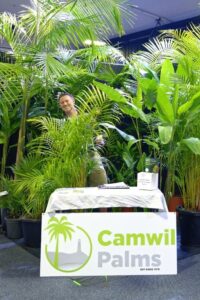
I found a similar sentiment when speaking with Craig Wilkinson from Camwil Palms, a production nursery near Byron Bay growing palms and subtropical foliage varieties, including Bangalow palms, kentias, golden canes, and rhapis. Craig said that this nursery sticks with what it knows: ‘We have done new before, but it is just the common adage, “If it ain’t broke, don’t fix it.” The common varieties sell. The market is quite a small market. We stick to the varieties that we can sell on a regular basis and there is plenty of space there for people doing that. Ours is more of a display to showcase what is going to be ready for spring. Most of my customers are from the south, that is Sydney and Melbourne. The expo gives them a chance to see what they can expect from us during spring through to early summer.’
Salvaged trees
Outside of the main pavilion, I caught up with Julian Ford and Michelle Tomkins from Epic Gardener who had some advanced feature trees on display. Based in Loganholme, this business specialises in salvaging trees but with a twist: rehoming plants to give them a second chance. As Julian explains: ‘People will have a tree in their front yard and buy a house and then decide that that tree does not suit their needs. They may want a bigger driveway and just want to get rid of the tree. We first try to get those people to rethink before clearing those trees. If that does not work, we will take those trees out of that situation and place them in our nursery or put them straight into someone else’s garden and try and save that specimen from getting destroyed.
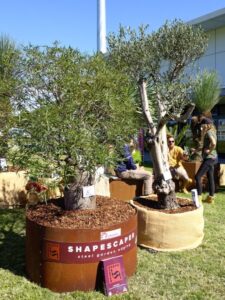
‘It is our first time at the Green Expo. ‘We came here for exposure and to get a feel about what it is like and what goes down here. Everybody wants to have a chat. Everybody has been coming in, taking cards and pamphlets. They are very impressed with the quality of the stock. We do not do quantity. We are all about the quality. When we harvest dragon trees, we do it to the best quality, so not a single scratch gets on them. Once a dragon tree branch is cut off, the tree changes forever and they do not regrow their natural pattern. Luckily, olive trees are the opposite; you can absolutely trim them up and do whatever you want with them! They are super hardy.’
Weed management
Along the way, I also visited ICL’s display, where I talked with John Walsh about that company’s recent Osmocote and pre-emergent herbicide trials. If ICL’s claims are correct, i.e. that roughly 60-70% of all plants in Australia are grown in Osmocote, then any improvements to that line of controlled release fertilisers may be a boon for the industry in general. That is very important when it comes to sustainability and minimising the use of precious planetary resources.
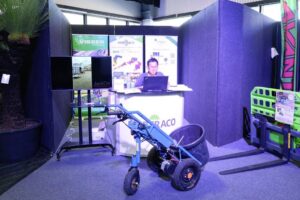
However, what grabbed my attention during my time with John was the approach he says ICL has with regards to weed management. ICL released a new pre-emergent herbicide last year, yet John says if you think you can control weeds in your nursery by using pre-emergent herbicides only, then you are wrong: ‘Pre-emergents do not really control weeds. Effective weed management is what control weeds. We have written a manual on how to manage weeds better. It starts with perfect sanitation. We have provided all the reasons why sanitation matters. If you are failing in your weed management system, then it is probably due to poor sanitation.
‘The second important consideration is weeding. Most people who have got weed problems are weeding entirely the wrong way. We have had a professor from the United States, Professor Joe Neal, come out and talk to us about the most effective, least-cost ways to weed in your nursery. The businesses that are weed-free use his methods. The ones that have got lots of weeds are those people who say, “I cannot afford to do that”, even though doing so would prove cheaper overall.
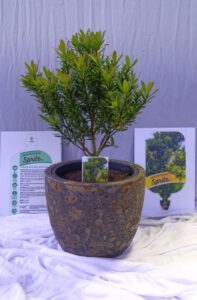
‘The last factor is the effective use of a good pre-emergent herbicide. We show people how to effectively apply them more effectively, conducting weed management training in nurseries with our staff.’
Bugs for Bugs
One of my favourite displays was that staffed by Darcy Filmer for Bugs For Bugs, promoting the use of beneficial insects and Integrated Pest Management (IPM) products to control pests with minimal chemicals. Who does not like looking at invertebrates under a microscope? According to Darcy, event-goers of all ages were very interested in better understanding IPM: ‘In the agricultural sector, it is usually the younger farmers that are keen on it. However, in this (horticultural) group, I am getting interest from all generations.
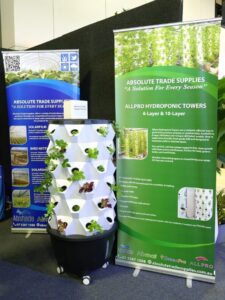
‘People have been asking questions about how the bugs work, and what they can do. The important thing is to get the best out of them that we can. We can all purchase products and put them out, whether it is a chemical or a bug. However, if we do not use them correctly, then we are not going to get the result that we desire. So, it is not as simple as just opening a bottle and here it is, put it out. You must work with the bugs. You need to think about what has been happening in your situation before, and what you plan to do there in the next few weeks afterwards to get the best out of your bugs.’
Darcy also wanted to share one simple, practical tip for all growers interested in better managing pest and disease: buy a jeweller’s loupe and wear it round your neck so that you have it close at hand when you want to more closely inspect any plant problems at your nursery.
Hydroponic Tower
Another product that caught my eye was the Allpro Hydroponic Tower that Absolute Trade Supplies had on display. Quentin Lovett told me that this tower was this business’ most popular product during the expo: ‘We have a lot of wholesale growers, particularly herbalists, who are using these hydroponic systems because it really maximizes their footprint. The home gardener can also put it on their balcony, or in the sunny corner of a room.’ Available in a range of sizes, soilless growing has never looked so good! Given the trend towards apartment living in our cities, we may just need a few more products like this on the market to give consumers more options to grow their own food close to home, especially high-value herbs and salad greens, which are most nutritious when picked and used immediately.
Through visitors’ eyes
Having spoken with many exhibitors, I wanted to find out what the expo means to the people visiting it. So, I whipped out my voice recorder and approached visitors to ask them why they had come.
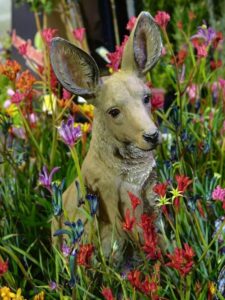
I spoke with locals Max and Brandon from Thrive Plant Wholesalers at Upper Coomera as they were making their way around the expo displays. This wholesale nursery produces a range of plants including Philodendron (Thaumatophyllum) ‘Xanadu’, syzygiums, monsteras, alocasias, murrayas, and olive trees. Max told me that he deals with many of the suppliers at the expo in his sales role: ‘The main reason why I like to come here is just to introduce myself and meet people. It is good to meet the people face to face that I speak to over the phone to get a bit of a feel about what is going on in the industry. We supply to Bunnings, so it is also good to see what is going around and the stock that is coming up.’ Max’s colleague, Brandon works in production, so he was on the lookout for equipment: ‘Things that can help us in our production processes at Thrive; basically anything from pots to tags to anything that will make our processes faster and easier.’
Surprisingly (to me!) I was not the only Tasmanian in attendance! I met Luke Force from Tibballs Nursery as he was making his way around the expo stands. Tibballs is a wholesale nursery specialising in flower and vegetable seedlings, including the Diggers range, located in Brighton, 30 minutes north of Hobart. Luke spoke to me about why he was here: ‘We have come along to have a look at the Green Expo and see what is on offer, and to do some networking with people that we talk to on the phone that we do not get to see in person. That has been really beneficial for us. We are also going to have a look at a couple of wholesale nurseries that do similar work to us while we are here. We are the grower for the Oasis network in Tasmania, and there are other Oasis growers here at the expo.’
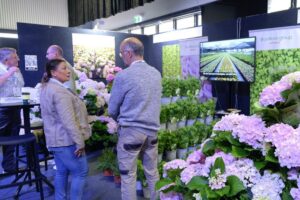
Where to from here?
Judging by the quality of the greenlife and products on display at the Green Expo, not to mention the diversity of services represented, it looks like the Queensland greenlife industry is in a very healthy state!
I will leave the final words to Colin Fruk, Chief Executive Officer of Greenlife Industry Queensland (GIQ). Colin spoke to the industry’s future in this state at the Green Expo dinner held at the Sea World Resort Conference Centre on Tuesday 28 July 2025.
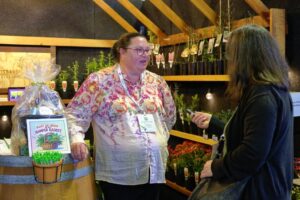
‘Across the state and the nation, the appetite for greenlife continues to grow, from homeowners creating backyard sanctuaries to large scale landscape construction, local councils investing in shade and cooling, schools creating green playgrounds, and governments restoring native habitats. We are seeing green infrastructure move from being a “nice-to-have” to an essential part of urban design and public health. The evidence is there. Our plants make our communities healthier, cooler, more connected, and that makes us, that makes you, essential. And that is not even counting what is ahead. As the eyes of the world turn to Queensland in the lead up to the 2032 Olympic and Paralympic Games, we are standing on the edge of an unprecedented opportunity.
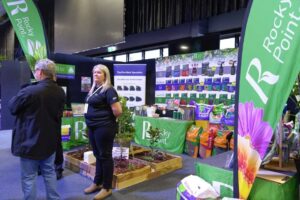
‘The Olympics decade will bring new development, new precincts, and new public expectations for sustainability and liveability. Greenlife is at the heart of all of that. The GIQ team is working hard to make sure our industry will have a seat at the table. As governments reimagine urban spaces from Victoria Park to the GABBA precinct, to new transport corridors, parklands, and suburban hubs. Every one of these projects is an opportunity for our industry, not just to supply plants, but to help create solutions that are greener more resilient and better for future generations.’
Exciting times indeed for Queensland horticulture! I cannot wait to see what will be on show at the 2026 Green Expo.
Image captions (All images: Ludovic Vilbert, Inwardout Studio)
